Bavaria is the largest state in Germany covering a fifth of the country's landmass and is home to the country's highest mountain and the largest lake.
Munich, the capital, is the third largest city in the country, while Bavaria has the second biggest population.
In certain ways Bavaria could be said to be the Scotland of Germany.
The similarities start with the comparable sizes - although Scotland is slightly larger, Bavaria does have double the number of inhabitants.
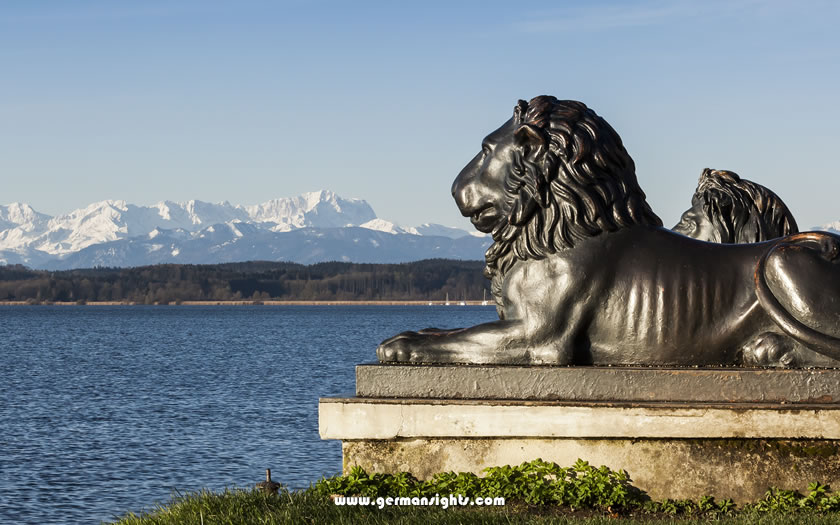
Tutzing, a village in Southern Bavaria on the Starnberger See
Both have their own powerful political parties representing regional interests.
Like Scotland, Bavaria was a sizeable, powerful and separate state for many centuries with its own royal family and regional history.
This has led a certain mental separation between the inhabitants and their neighbours in the rest of the country - many Bavarians tend to think of themselves as Bavarian first and German second.
Equally both Bavaria and Scotland tend to exert a political and cultural pull which is often at odds with the mainstream political centre of the country.
However, it would be fair to say that the left-of-centre and more radical Scottish National Party would not necessarily find too many echoes in the relative conservatism of the Bavarian CSU.
The towns and villages in Bavaria covered here are listed under the Locations link on the top navigation.
Information about getting to Bavaria and getting around the state once here can be found on our Bavaria Travel page.
Some of the natural sights, historic buildings and places of cultural interest are listed under the other tabs. Alternatively, you can check the following sections for links to specific locations in Bavaria:
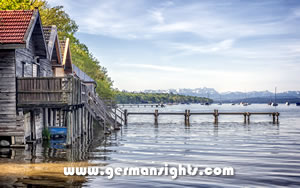
The Ammersee is situated southwest of Munich between the towns of Herrsching and Diessen am Ammersee. The lake is popular with visitors from Munich (it is at the end of a regional train line) and offers a variety of recreational activities, including swimming, boating, fishing, and hiking.
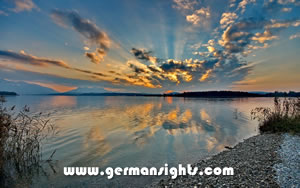
The Chiemsee is the largest lake in Bavaria and is situated to the southeast of Munich not far from the Austrian border. The islands of Herrenchiemsee (with its palace) and Fraueninsel are popular destinations for the ferries. The lake is also on the Alpine Road route in southern Germany.
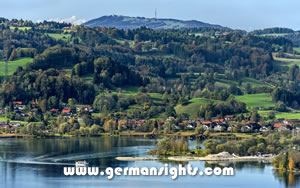
The Kochelsee is a small lake in the foothills of the Bavarian Alps. The small town of Kochel is the main settlement on the lake and a road over a mountain pass leads through to the Walchensee. A summer ferry service operates around the lake.
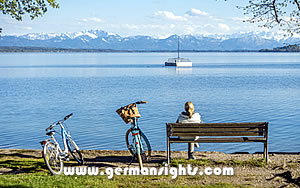
The Starnberger See is the second largest lake in Bavaria and is situated to the southwest of Munich. It offers spectacular views of the mountains to the south and is a popular destination for day trips from the city. A ferry service links the towns on the lake shore.
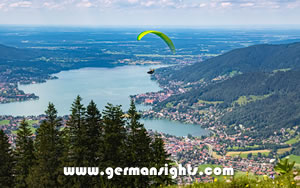
The Tegernsee lake is one of the most popular day-trip destinations from Munich as well as being a holiday location in its own right. There are various lake resort towns around the village, with Tegernsee itself being the site of the original settlement by monks.
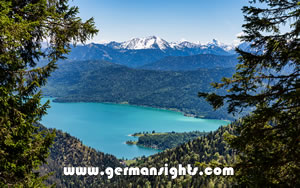
The Walchensee is one of the deepest and largest alpine lakes in Germany. It is located in the middle of the Bavarian Alps, 75 kilometres south of Munich. The lake is a popular destination for swimming, windsurfing, and hiking.
And, of course, let's not forget Lake Constance - even if the border is shared with Baden-Württemberg, Austria and Switzerland.
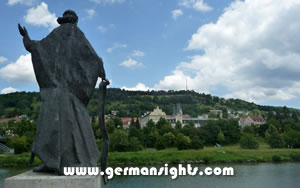
The Naturpark Altmühltal was created at the end of the Sixties and lies between the population centres of Regensburg, Nuremberg, Augsburg and Ingolstadt. The nature reserve can be explored on the cycle path or on a walking trail of 200 kilometres through the valley.
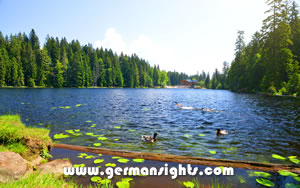
The Bavarian Forest is an area of ancient mountain woodlands on the border between Germany and the Czech Republic. It stretches from the border with Austria near Passau up the eastern bank of the Danube to the Upper Palatinate region of Bavaria.
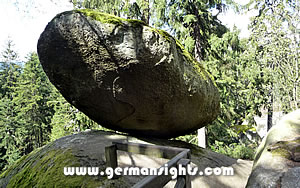
The Fichtelgebirge are a range of mountains covering an area of approximately 1600 square kilometres in northeastern Bavaria and the northwestern part of the Czech Republic. Much of the region is protected by the Naturpark Fichtelgebirge nature reserve.
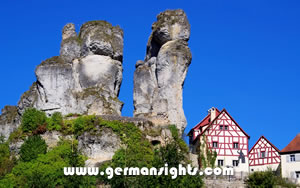
The area known as Franconian Switzerland is a hilly region between Bayreuth, Bamberg and Nuremberg. It is very popular with walkers and mountain bikers - there are a number of long-distance trails winding their way through the valleys and the rock formations.
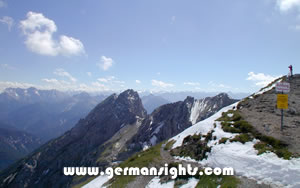
The Karwendel mountains are a range of limestone peaks and ridges running along the border between the Austrian Tyrol and Bavaria. Both sides of the border are protected nature reserves and together form one of the largest protected areas in the eastern part of the Alps.
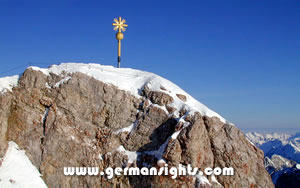
The Zugspitze lies in the Wetterstein range, a chain of limestone peaks marking the border between Austria and Germany and stretching from Ehrwald in the Tyrol through to Mittenwald in Bavaria. It is Germany's highest mountain and can be reached either by cable car or cog railway.
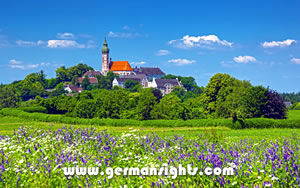
Andechs monastery is one of the most famous religious institutions in Bavaria - not only because of its history and lovely location on a hill above the Ammersee but also because of the food and drink served there in the traditional brewery. It is easily reached from Munich.
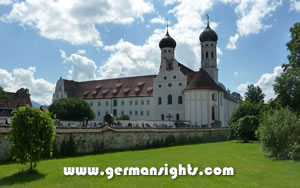
Benediktbeuern Abbey - one of Bavaria's oldest and best-preserved - is situated just outside the village of the same name on the way between Kochel am See and Bad Tölz. The location makes it a good stop for those travelling the scenic German Alpine Road route.
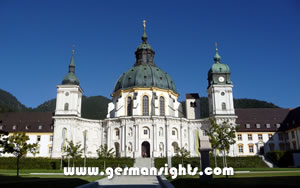
Ettal Abbey is part of a cluster of historic sights on the German Alpine Road. Nearby Oberammergau has its famous Passion Play and Linderhof Castle, one of King Ludwig's architectural flights of fancy, is only a short drive away down the Graswang valley.
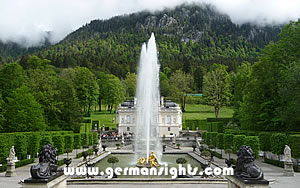
Linderhof Castle is more of a country residence than a formal palace, but the grounds hold more of King Ludwig II's fantasy ideas, including the Venus Grotto, which used electric power to transport him across a miniature lake in a boat shaped like a swan.
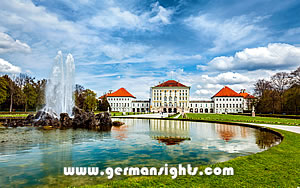
This impressive palace complex is located in the western suburbs of Munich. The palace was a summer residence of the rulers of Bavaria and dates back to the 17th century. The buildings are set in 500 acres of parklands and are easily accessible on Munich's public transport system.
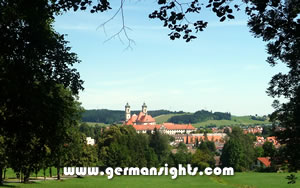
Ottobeuren Abbey can trace its history back to the 8th century, when it was founded by Benedictine monks. These days it is also well-known for the classical music concerts held in the abbey. It also has a famous choir school and a library that contains over 120,000 volumes.